Blog Body
Are your digital projects adrift without a compass?
Discover how Digital Transformation Governance sets the rules to avoid chaos, maximize ROI, and confidently achieve Vision 2030 goals. This isn’t a technical guide, but a strategic roadmap for infallible leadership.
Beyond Technology: The Hidden Compass for Digital Success
Saudi Arabia is in a heated race toward the future, fueled by digital transformation that permeates every aspect of the state and society, from instant government services to smart cities and automated factories. Amidst this massive momentum, driven by Vision 2030, both government and private institutions are investing billions in adopting the latest technologies: artificial intelligence, cloud computing, the Internet of Things, and big data analytics.
But amidst the glimmer of technology, a fundamental question arises: What ensures these massive investments will yield the desired results? What prevents these initiatives from becoming isolated digital islands or failed projects that drain resources without delivering real value?
The answer lies in a concept that may not shine as brightly, but it is the cornerstone of any successful digital journey: Digital Transformation Governance. It’s the compass that guides the ship, the constitution that regulates the relationship between all parties, and the control tower that ensures all digital planes take off and land safely. This article is your guide to understanding what this governance is, its utmost importance in the Saudi context, and how to build an effective framework that ensures your digital ambitions transform into tangible and sustainable reality.
What is Digital Transformation Governance? (Unraveling the Most Important Term)
The term “governance” is often misunderstood, with some associating it with bureaucracy and restrictions that hinder innovation. In reality, Digital Transformation Governance is quite the opposite; it’s an enabling framework that unleashes organized and purposeful innovation.
Simply put, digital transformation governance is: A set of policies, processes, organizational structures, roles, and responsibilities that ensure an organization’s digital transformation initiatives align with its strategic objectives, effectively manage risks, and maximize the value realized from technology investments.
It’s not about managing technology, but about leading the change that technology brings. Think of it this way:
- Without Governance: The marketing department might launch a new application, while the operations department implements a different automation system, and HR buys a third cloud system. The result: chaos, duplicated efforts, wasted money, and systems that don’t communicate with each other.
- With Governance: All these initiatives are evaluated by a steering committee, ensuring their alignment with the overall strategy, allocating resources based on priorities, guaranteeing their integration and security, and measuring their return. The result: harmony, efficiency, and achievement of goals.
Therefore, digital transformation governance is the guarantor of transforming haphazard spending on technology into strategic investment with a clear return.
Why is Digital Transformation Governance a Necessity, Not a Luxury, in Saudi Arabia?
In the Saudi context, the importance of this concept doubles, becoming an indispensable strategic necessity for several crucial reasons:
- Achieving Vision 2030 Goals: The Kingdom’s Vision 2030 is the comprehensive national plan, and all digital transformation initiatives must contribute to achieving its objectives. Governance ensures this alignment, prevents projects from deviating from the national path, and guarantees that every Riyal spent contributes to building a diversified economy, a vibrant society, and an ambitious nation.
- Managing Huge Investments: The Kingdom is pouring massive investments into projects like “NEOM,” “The Line,” and transformation programs across all sectors. Without effective governance, there is a significant risk of wasting these resources. Digital Transformation Governance ensures that these investments are managed transparently and efficiently to achieve maximum possible return.
- Managing Cyber Risks and Data Protection: With every new system launched, the attack surface exposed to cyberattacks increases. Governance integrates cybersecurity into the core of the transformation process from day one, not as an afterthought. It also ensures compliance with personal data protection legislation supervised by entities like “SDAIA,” protecting the organization from fines and reputational loss.
- Enhancing Integration Between Entities: One of the biggest challenges of comprehensive transformation is breaking down silos between different departments or even between government entities. Governance provides a common platform and mechanisms for coordination and collaboration, ensuring the building of an integrated digital ecosystem that efficiently serves citizens, residents, and investors.
Key Pillars of a Successful Digital Transformation Governance Framework
Building an effective governance framework is not a complex process; rather, it requires adherence to a set of fundamental pillars that together form an integrated system:
Pillar One: Leadership & Strategic Vision
- What it means: Commitment to governance must come from the top of the organizational hierarchy (board of directors and executive management). This requires forming a Digital Transformation Steering Committee with representatives from all key business units (technology, finance, operations, human resources, marketing).
- Its role: Establishing a clear digital vision, defining strategic priorities, allocating budgets, and periodically monitoring progress.
Pillar Two: Data Governance
- What it means: Data is the fuel of digital transformation, and its governance is the key to leveraging it. This includes setting clear policies on data ownership, quality, classification (public, confidential, top secret), security, and privacy.
- Its role: Ensuring that data used in decision-making is accurate, reliable, and secure, and complying with local regulations such as the policies of the National Data Management Office (NDMO).
Pillar Three: Risk & Cybersecurity Management
- What it means: Proactively identifying, assessing, and managing risks associated with digital transformation, including technical, operational, financial, reputational, and most importantly, cybersecurity risks.
- Its role: Integrating cybersecurity controls into every stage of digital projects, from design to implementation and operation, to ensure the building of inherently secure systems.
Pillar Four: Change Management & Communication
- What it means: Digital transformation is primarily a human transformation. Change management means preparing employees and beneficiaries for new technologies and processes, training them, and addressing their concerns and resistance to change.
- Its role: Building acceptance and support for digital initiatives, and ensuring that the workforce is a partner in success, not an obstacle to it.
Pillar Five: Performance Measurement & Value Realization
- What it means: “What cannot be measured cannot be managed.” Clear Key Performance Indicators (KPIs) must be defined for each digital project to measure its success in achieving its objectives.
- Its role: Shifting focus from “project completion” to “value realization,” and providing tangible data for senior management to make informed decisions about future projects.
The Digital Government Authority (DGA): The Orchestra Conductor in the Saudi Scene
Recognizing the utmost importance of this concept, the Kingdom of Saudi Arabia established the Digital Government Authority (DGA) to be the regulator and enabler of government digital transformation. The Authority plays a pivotal role in implementing digital transformation governance at the national level by:
- Issuing regulatory frameworks, standards, and policies such as the “Digital Governance Framework” to unify efforts.
- Measuring the digital maturity of government entities and motivating them to develop.
- Overseeing shared digital platforms to enhance integration.
The existence of an authority of this size and influence confirms that digital transformation governance is no longer a theoretical option, but an essential institutional practice for leading digital success in the Kingdom.
Renad Almajd: Your Digital Transformation Governance Strategy Engineer
Understanding governance principles is one thing, and effectively applying them on the ground is another entirely. Implementation requires deep expertise that combines an understanding of business strategies, mastery of technical tools, and the ability to manage change. This is where the strategic partner who can turn theory into reality comes in.
At Renad Almajd, we see ourselves not just as a provider of technical solutions, but as “Governance Strategy Engineers.” We understand that the success of your digital journey depends on a solid foundation of governance. Therefore, we work hand-in-hand with our clients in both the government and private sectors in the Kingdom to develop a digital transformation governance framework specifically designed to suit their unique goals and challenges. Our consulting services help you to:
- Build the Governance Organizational Structure: We help you design and activate the digital steering committee and define its roles and responsibilities.
- Develop Policies and Procedures: We work with you to formulate clear policies for project, data, and risk management.
- Choose the Right Metrics: We help you define the Key Performance Indicators (KPIs) that measure the true value of your digital initiatives.
- Ensure Alignment and Compliance: We ensure that your strategy aligns with the requirements of regulatory bodies such as the Digital Government Authority (DGA) and the National Cybersecurity Authority.
Transform Chaos into Value: Move Towards the Future with Confidence with Renad Almajd
Digital transformation without governance is a high-risk gamble. However, digital transformation led by sound governance is a guaranteed strategic investment with a clear return. The decision between the two paths is yours.
A Call to Leaders of Organizations, Technology Managers, and Strategic Planning Officials in the Kingdom:
Are you ready to set the right compass for your digital journey? Do you wish to ensure that every technology investment translates into real added value that serves your goals and aligns with Vision 2030?
The expert team at Renad Almajd is fully prepared to be your partner on this journey. We invite you to benefit from an initial strategic consultation, so we can explore together how we can help you build a digital transformation governance framework that transforms potential chaos into organized value and propels your organization towards a future of sustainable growth and digital leadership.
Don’t leave your success to chance. Contact Renad Almajd today, and let us build the foundations of your digital future together.















